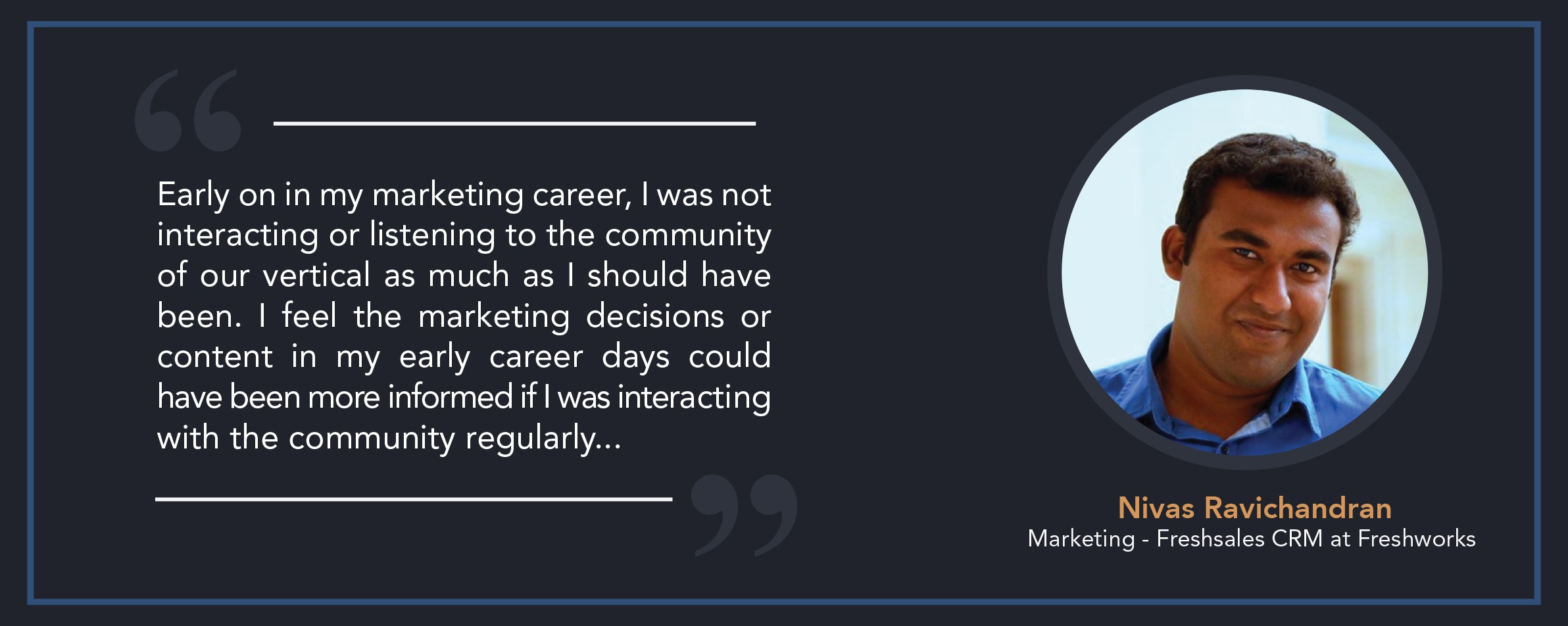Article's Content
Raise your hand if you’ve ever made a mistake during a marketing campaign. If you’re like most of us, you’ve probably committed more marketing faux pas than you want to admit. Mistakes are common in the marketing world; after all, none of us started out as experts, and even experts make mistakes now and again.
To prove it, we spoke to nearly 30 SaaS marketers from around the globe—some at high-growth companies, some working at agencies as well as solopreneurs in the SaaS space—and asked the big question:
“Have you ever committed a marketing faux pas, and what did you learn from it?”
The result? All but one said yes!
I’ll repeat:
Almost ALL SaaS marketers have made a marketing faux pas at some point in their career.
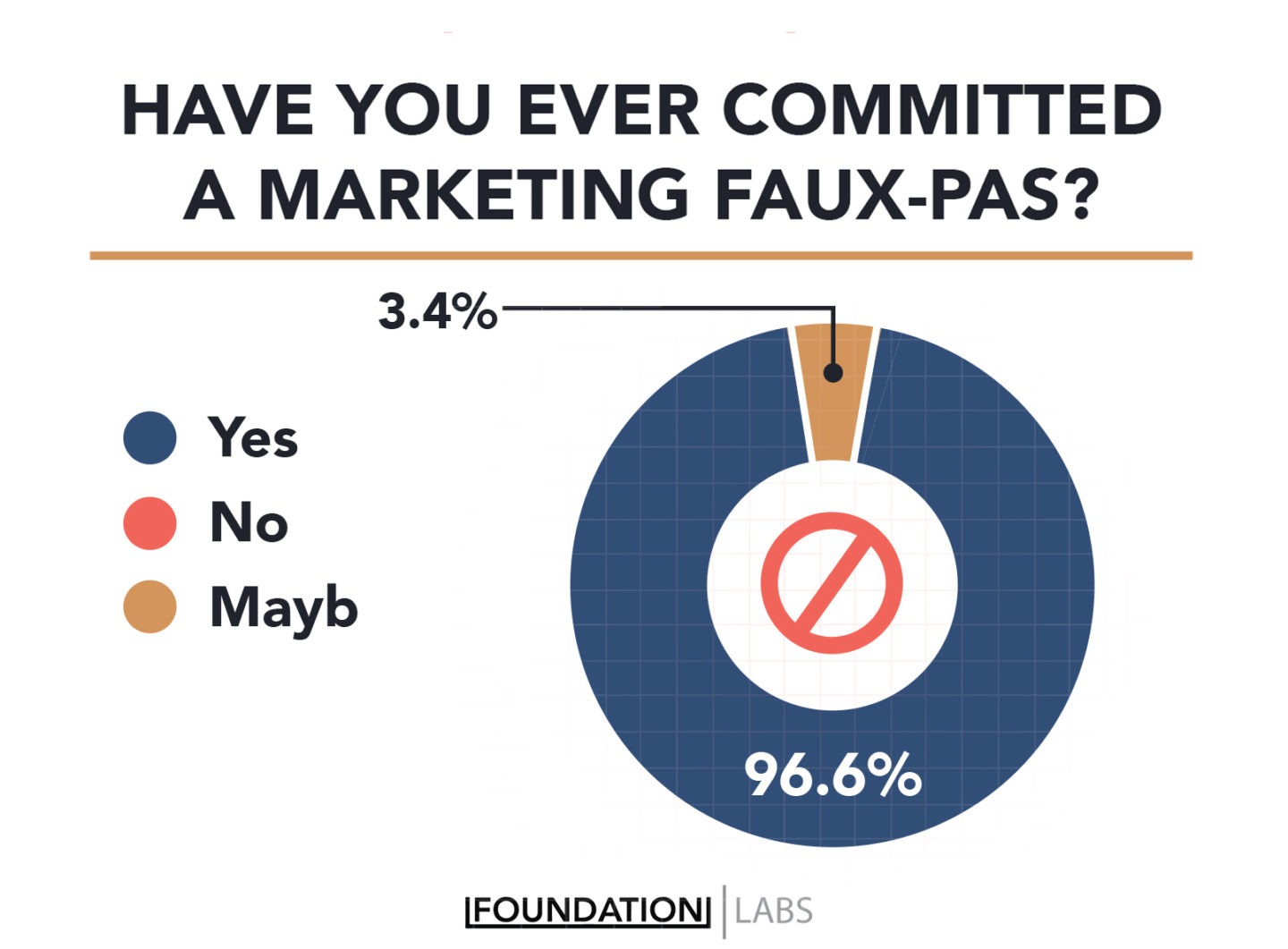
That’s huge.
It shows us that while we all aspire to become T-shaped (or I-shaped) marketers, the journey isn’t a linear one.
The problem is when we don’t admit our weak spots.
Claire Suellentrop, who co-founded Forget the Funnel, told us that for a long time, she didn’t want to admit what she didn’t know.
I wanted to look like I had it all figured out, long before I had much of anything figured out.
But here’s the thing: We won’t improve as marketers until we admit what we don’t know and learn from others who do. Claire says she wasted a lot of time “trying to do everything myself, rather than acknowledging my weak spots and seeking the advice of others who were more experienced.”
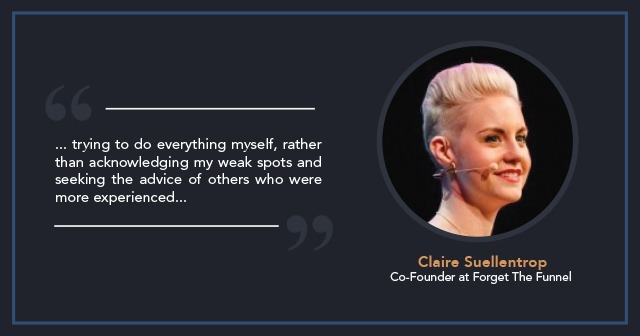
That’s why we collected the past mistakes from our SaaS marketing experts: to help you avoid those same pitfalls and become a better marketer in 2020.
Learning from mistakes is imperative for success in any field, and today you’re going to have a chance to do exactly that. Here are 13 common marketing mistakes that every SaaS marketer should avoid:
Mistake #1: Trying To Reinvent The Wheel

Marketing is all about experimentation, whether it’s a new process or a new tool. We aren’t a tribe that shies away from the new.
However, sometimes marketers make tasks more complicated than they should be. In a role where time is money and there’s always a ton of stuff on your to-do list, trying to reinvent the wheel only brings chaos and eats up precious time.
In a survey we conducted, 57.1% of marketers admitted that they have tried to reinvent the wheel for a marketing campaign. And reinventing the wheel also applies to the actual channels and strategies you implement. Don’t neglect channels such as good old-fashioned email, short code texting, or other forms of SMS. While it’s good to be innovative, some approaches are commonly used for a reason – because they work.
Brittany Berger, who worked at Mention and now runs a successful consulting business, says she tried to do things her own way when it came to cold personal outreach—and her efforts backfired.
Her mistake? Trying to personalize every email in an extensive cold campaign without using an outreach tool, which exists for that very purpose and can save marketers lots of time. Here’s what happened:
In my rush to personalize and send over 100 emails in too short of a time window, I sent a *bunch* that were personalized to the wrong person, also had {RESEARCH THEM AND PUT SOMETHING HERE} below the personalization in the email, had random typos, etc.
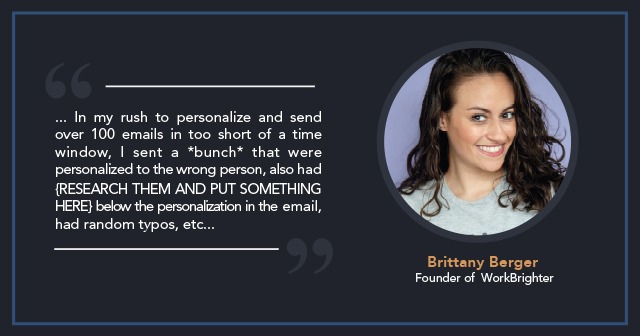
Oof! That has to hurt.
Key Takeaway:
While going the extra mile may seem like a good idea, reinventing the wheel is often pointless—or worse, it can take time away from other important tasks. As marketers, we shouldn’t shy away from using tools and processes that have already been optimized, especially when they help us save time and resources.
Mistake #2: Over-Complicating The Message

Everything that we design is for the customer—the person who will eventually use our products or buy our services. Yet sometimes, we make our marketing campaigns so complex that our audience has a hard time understanding the message, or it just doesn’t resonate.
That’s why the best marketers say that over-complicating your messaging or your marketing strategy is a major mistake—and it’s a common one. 52.4% of respondents in our survey said they’ve made this mistake.
In a Harvard Business Review article on simplifying your customers’ decision making, Patrick Spenner and Karen Freeman said:
The rising volume of marketing messages isn’t empowering—it’s overwhelming. Rather than pulling customers into the fold, marketers are pushing them away with relentless and ill-conceived efforts to engage.
Shayla Price, an award-winning B2B SaaS marketer, learned this lesson the hard way:
Early in my career, I failed to write straightforward calls-to-action in my content. This mistake confused visitors and resulted in high bounce rates. It was a missed opportunity to engage potential customers and move them to the next step in the sales funnel.
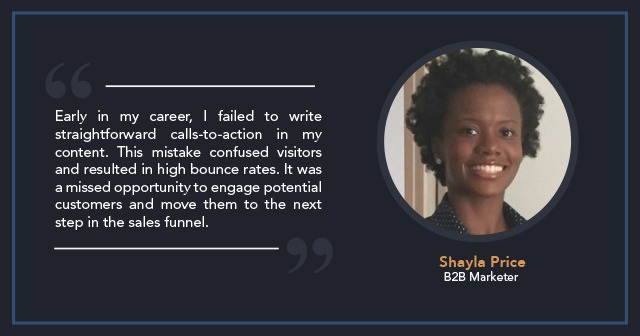
Key Takeaway:
Simplifying your marketing messages—and your whole strategy for engaging customers—will always make you the winner.
Marketing Mistake #3: Going Overboard With Marketing Efforts
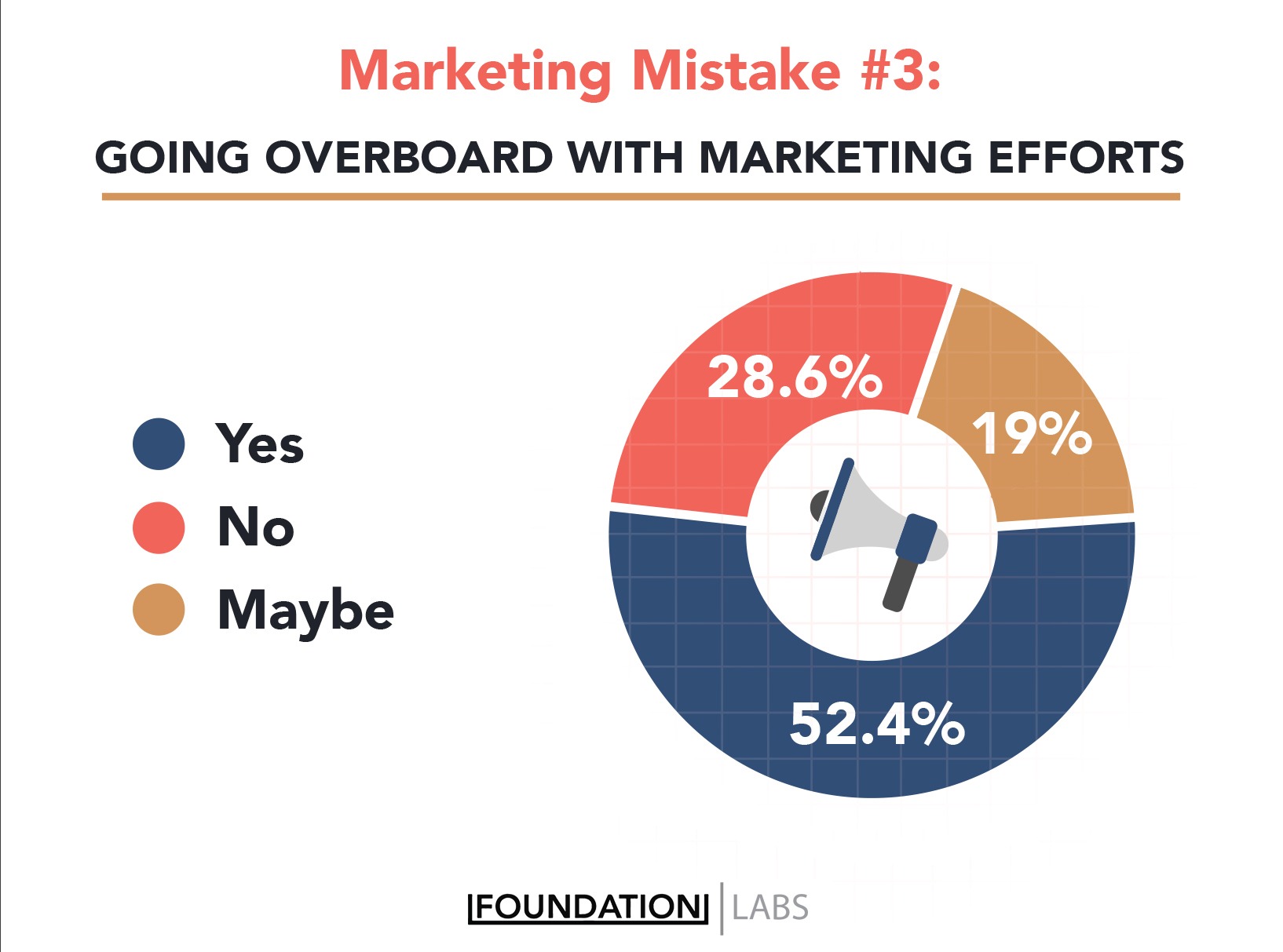
We get fixated on moving new campaigns forward as quickly as we can. It’s a lot of hard work but we do it because a great campaign usually results in quality leads; however, sometimes we bite off more than we can chew—we forget to draw a line and end up going overboard.
One of our survey respondents (who wanted to be kept anonymous) talked about a time when she “helped manage a social UGC-based campaign that was built around sending some swag to agencies.”
This is a common practice among SaaS companies, but she explained that “the views and engagement were not very high, and looking back the amount of effort put in did NOT justify the low ROI.”
She’s not alone: 52.4% of marketers we surveyed admitted to going overboard with their marketing efforts.
This mistake is especially tempting for startups because they want to do everything they can to prove their worth to their customers, which often backfires.
Patrick Whatman, who is currently associated with Spendesk, recalled a time when he and his team put in a whole lot of work—with nothing to show for it:
Early on (in a previous role), we tried to create as many different ebooks, checklists, and guides (gated) as possible, to cover every possible tiny use case that someone might have for our tool. We thought that if we didn’t do this, we wouldn’t be able to offer the right guides to all sorts of different prospects.
As a result, we have a lot of these guides with very low numbers of downloads, even though we invested time and effort in creating them. And those who did download weren’t necessarily good leads for us since they only wanted one small aspect of our offer.
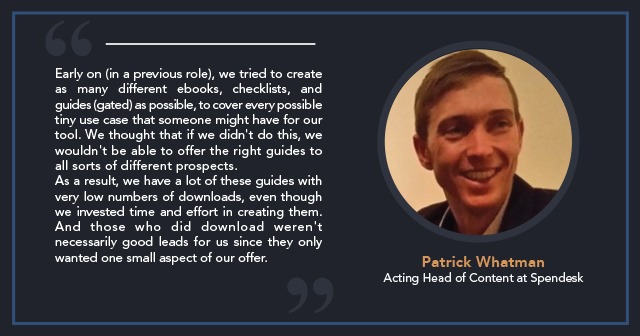
Key Takeaway:
It’s hard to gauge the success of a marketing campaign, but some extra diligence will not only save time but also allow you to identify and focus on platforms that give you direct ROI. It will also help you foresee whether your campaign is designed to attract the right audience.
Marketing Mistake #4: Failing To Have Documented Marketing Processes
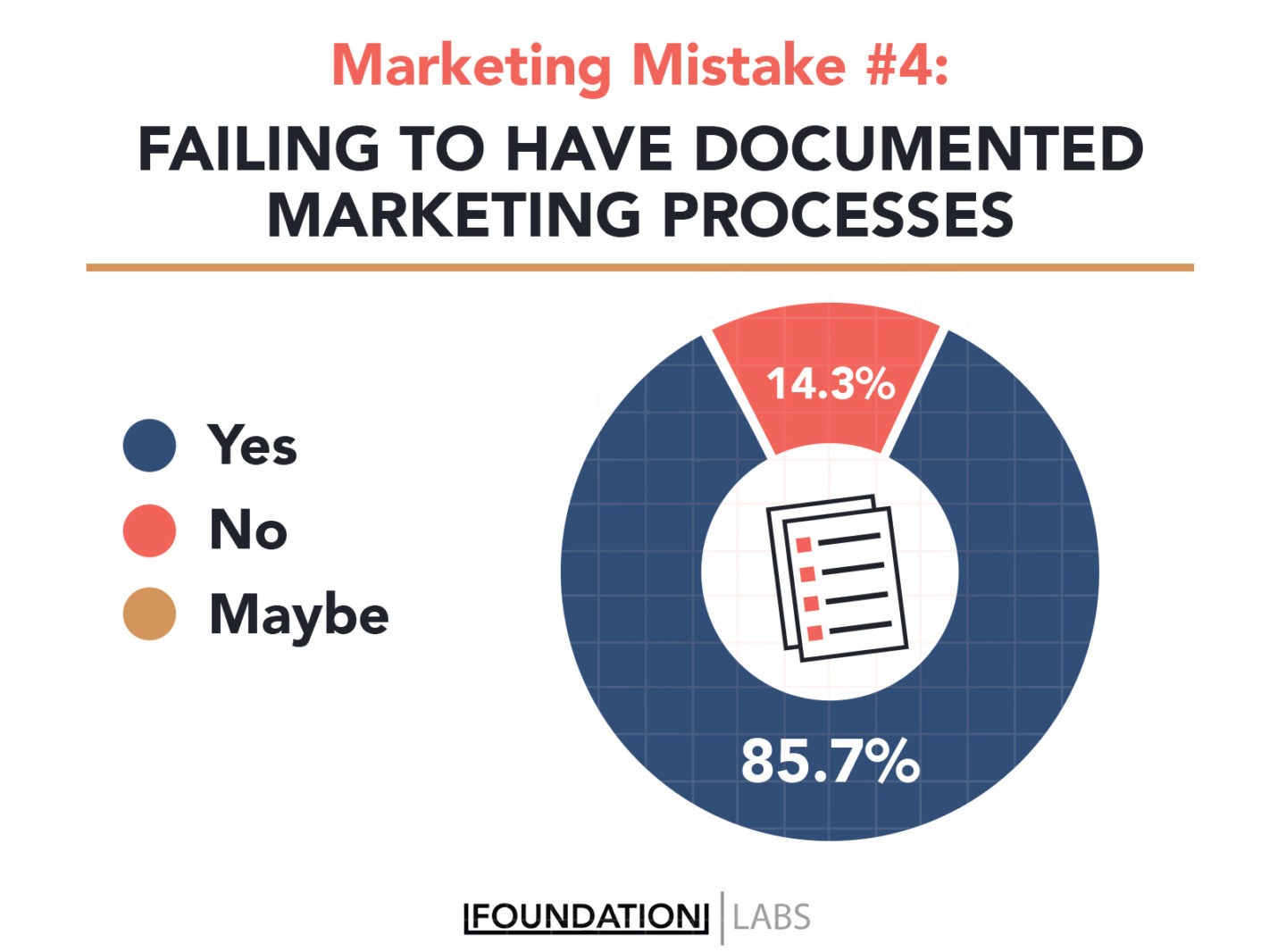
Marketers with a documented process are 466% more likely to report success. Yet for many marketers, this only becomes clear after they’ve already messed up a campaign or jeopardized an opportunity for improvement.
In fact, 85.7% of our survey respondents have made the mistake of not having a documented marketing process.
Shanelle Mullin, acquisition optimization at Shopify, was honest about the opportunities she missed:
I would chase tactic after tactic instead of following a structured process. Truthfully, that mistake wasn’t as detrimental in 2007 as it would be today given how saturated Internet marketing has become, but I still know I missed a lot of optimization opportunities.
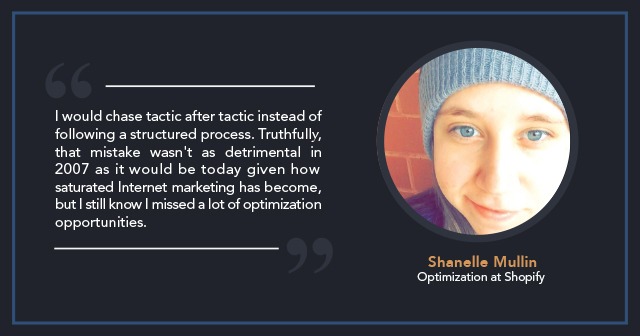
Here’s another story that screams the need for a strong marketing process. In the early days of Venngage, Nadya Khoja and the team did not have a strong process in place for making marketing-led changes—when making changes to their website, they made slapdash decisions based on speculation:
We decided it was time to change the functionality of the templates page and updated a design without really talking to users about it or doing any research into how we could structure it for the most marketing/product/engineering AND user benefit.
The templates page she referred to is an extremely high-value asset for Venngage—it has a domain authority of 80 and attracts tons of organic traffic (around 39.2K).

Back to their off-the-cuff strategy—did it work? Nope, not really.
Unfortunately, a lack of understanding about how the new framework we were using for building the page actually worked, and without proper SEO checklists and testing in place, we ended up shooting ourselves in the foot and accidentally deindexing the page.
Here are two graphs that show the corresponding dip in their traffic:
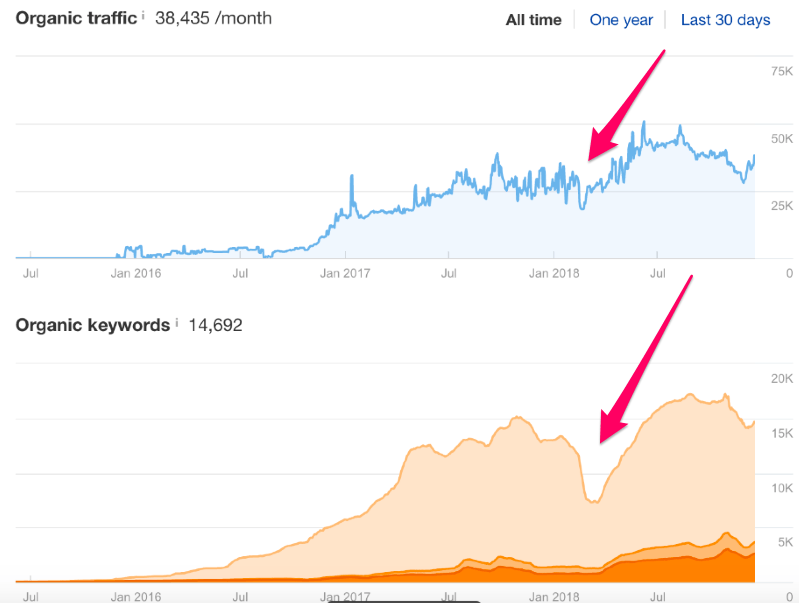
A dip in traffic wasn’t the problem for Lisa Abbott, VP of marketing at Wootric, who was tasked with driving inbound traffic when she was a marketing lead at an early stage B2B startup. She succeeded, and lots of leads were turned over to sales.
But unfortunately, those leads did not necessarily lead to conversions. The mistake she pointed to was—you guessed it—the lack of a process.
Partly due to budget constraints and partly due to prioritizing other strategies, I did not put in place a marketing automation system to make sure each and every lead was nurtured down the funnel and qualified by marketing from the start. I’m sure that as a result, potential business slipped through the cracks.
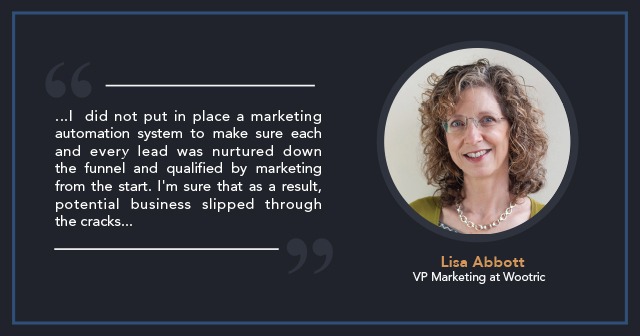
Key Takeaway:
Always approach marketing in a structured, methodical way—ideate, prioritize, test and analyze is a simple framework you can use. When you have documented processes, your decisions are guided less by ego and personal opinion, and more by data. Processes also make it easier to get the whole team moving in one direction.
Marketing Mistake #5: Not Defining Key Metrics In The Marketing Plan
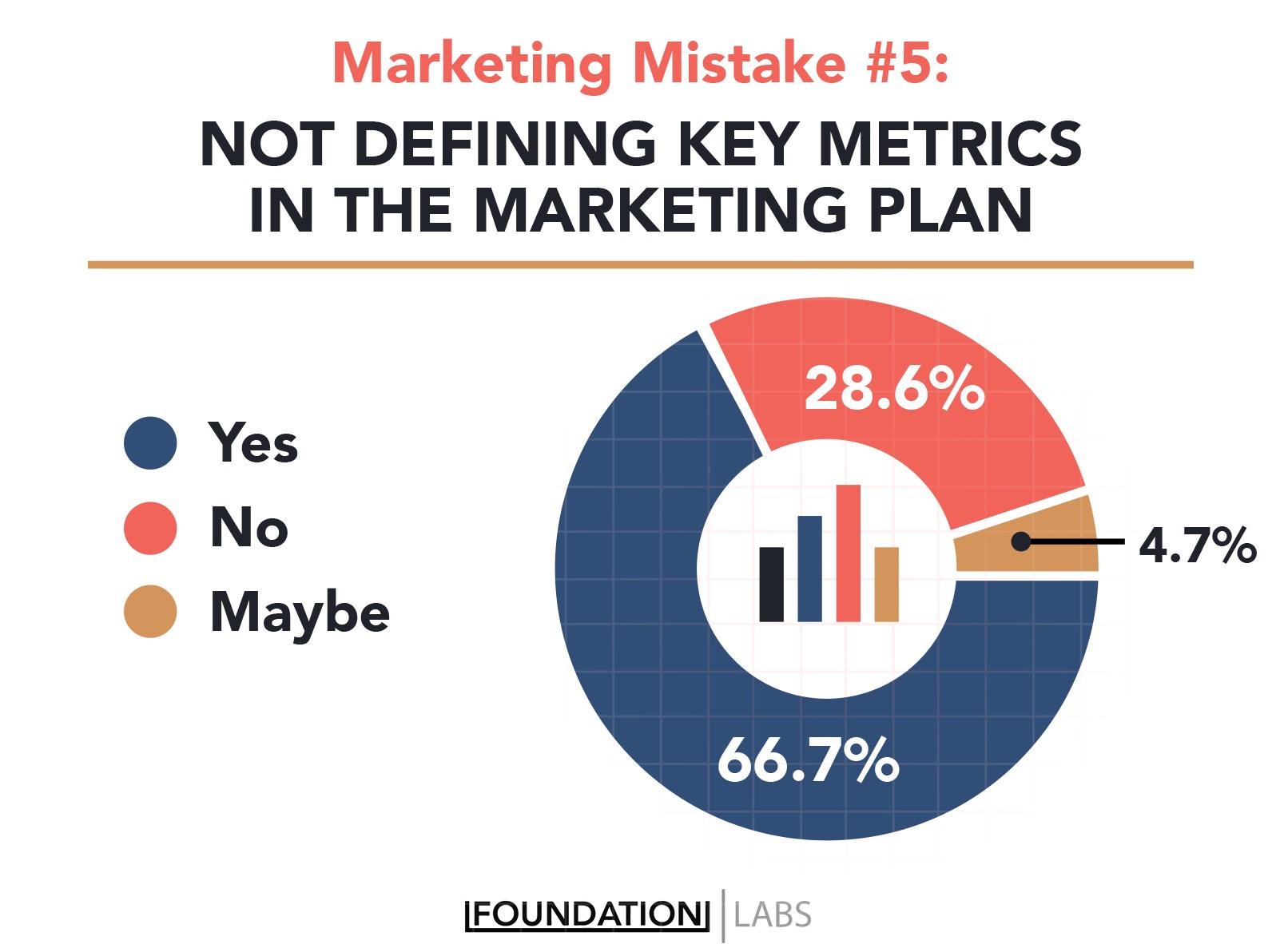
Metrics are integral to the success of any campaign—without metrics, it’s difficult to analyze a campaign’s performance and gauge its scalability. It’s a cardinal sin to not tie your campaigns to at least one metric!
But what’s shocking is that many marketers still run campaigns without defining their metrics—66.7% of marketers who took our survey said they were guilty.
Christina Pashialis, who has worked with brands like Geckoboard, told us one of the biggest faux pas she’s committed was “running sporadic campaigns without defining the main outcome desired, without defining how success will be tracked, and without documenting learnings after the campaign.”
For example, she once ran an event with the goal of “lead generation.” Looking back, she realized this was a mistake because
there was no clear definition of what an event lead is, no clear follow-up plan for attendees. This meant the topics of talks at the event were pretty random, there were no next steps and months later I had no idea whether event attendees had become leads!
In fact, at the end of the day, she “couldn’t articulate whether the event was a success or not.”
And that’s why clearly identifying your key metrics and how you’re going to achieve them is so critical. You shouldn’t spend money on AdWords for the sake of spending money on AdWords. You shouldn’t spend money on content marketing for the sake of spending money on content marketing. You need to understand the why behind your efforts and what success looks like.
Another mistake that’s closely tied to not identifying key metrics is not having enough data!
Marketers—especially freelancers and independent contractors—often fail to be proactive in seeking access to marketing analytics dashboards, email automation systems, and other data platforms before starting a project. Lianna Patch, who’s been a solopreneur for a long while, lamented:
It’s so tempting to say, ‘Yep, I can definitely improve that’ and get excited about the work. But if you don’t know the baseline metrics for what you’re improving, you get to the end of the project and have no real way to measure your (presumably killer) results.
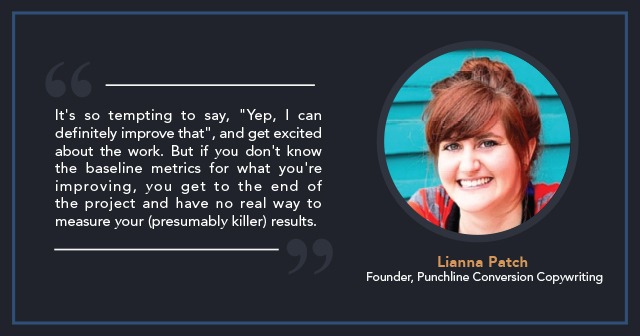
Key Takeaway:
Before running a campaign, define your main goals and the metrics you’ll be tracking—and what success will look like. If you are a freelancer/solopreneur, seek access to data. In the end, document your learnings—this approach allows you to iterate for future SaaS marketing plans and explain learnings to stakeholders and managers.
Marketing Mistake #6: Ignoring The Results Of Past Campaigns

We, marketers, are a stubborn bunch. Despite the continued failure of certain channels or strategies, some marketers try and try again in hopes that they’ll suddenly start to see results.
42.9% of the marketers who took our survey have made this mistake in their career.
A respondent who preferred to stay anonymous talked about how they invested in channels despite data that suggested their efforts were a lost cause. “Early on in my career, my team and I invested paid spend into a channel that has not historically been performing well for us,” she said.
Their belief was that they could overcome history with optimization, but in the end, the data were right. “It came as no surprise,” she added—and it shouldn’t have.
Key Learning:
It’s great to experiment; however, if a channel is consistently not performing, it’s wiser to abandon that path rather than waste time and resources.
Marketing Mistake #7: Not Taking Enough Time To Reflect
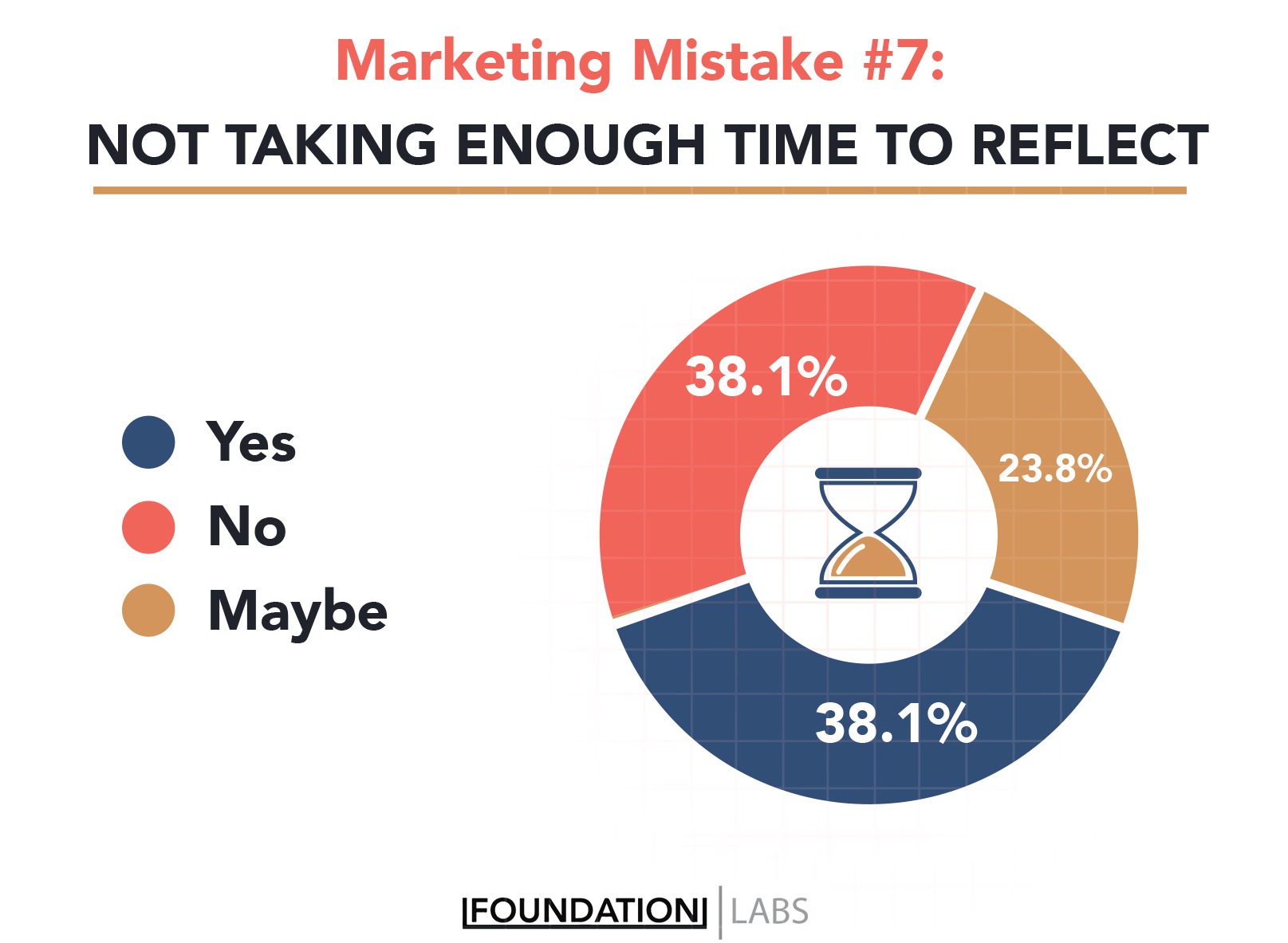
This mistake was not as prevalent among the marketers we surveyed, but more than a third fessed up to skipping this important step in the strategizing process.
While developing new campaigns is always on the agenda, reflecting on past and present campaigns should be too.
Why is reflection important? It forces you to slow down and evaluate the success of your strategies. As marketers, we like to keep moving forward, but if we don’t take time to pause and reflect, we run the risk of plowing ahead with strategies that aren’t actually helping the business or solving the problem they’re meant to solve.
Samantha Anderl, former head of marketing at Campaign Monitor, put it this way:
An early mistake that I made in my career, and which I see often is committing to a plan/strategy and moving forward for too long without taking the time to reflect. Taking the necessary time to reflect and assess the impact of the strategy on the business is of utmost importance. I’ve seen businesses take a major revenue hit because we agreed to move away from a tactic, change personas or build something new without taking the time to check in periodically and see how that decision was impacting the business.
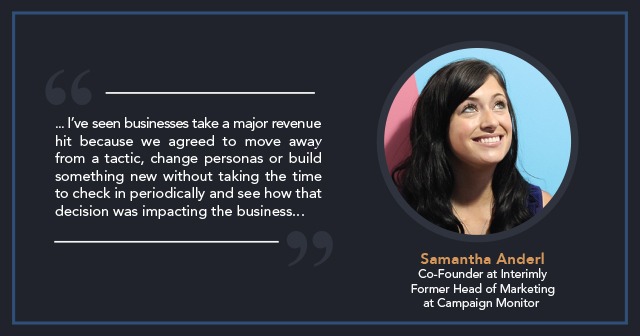
Key Takeaway:
Take time to reflect on the past while planning campaigns for the future. If not, you may move in a direction that negatively impacts the business.
Marketing Mistake #8: Not Double-Checking Work When Using Automation
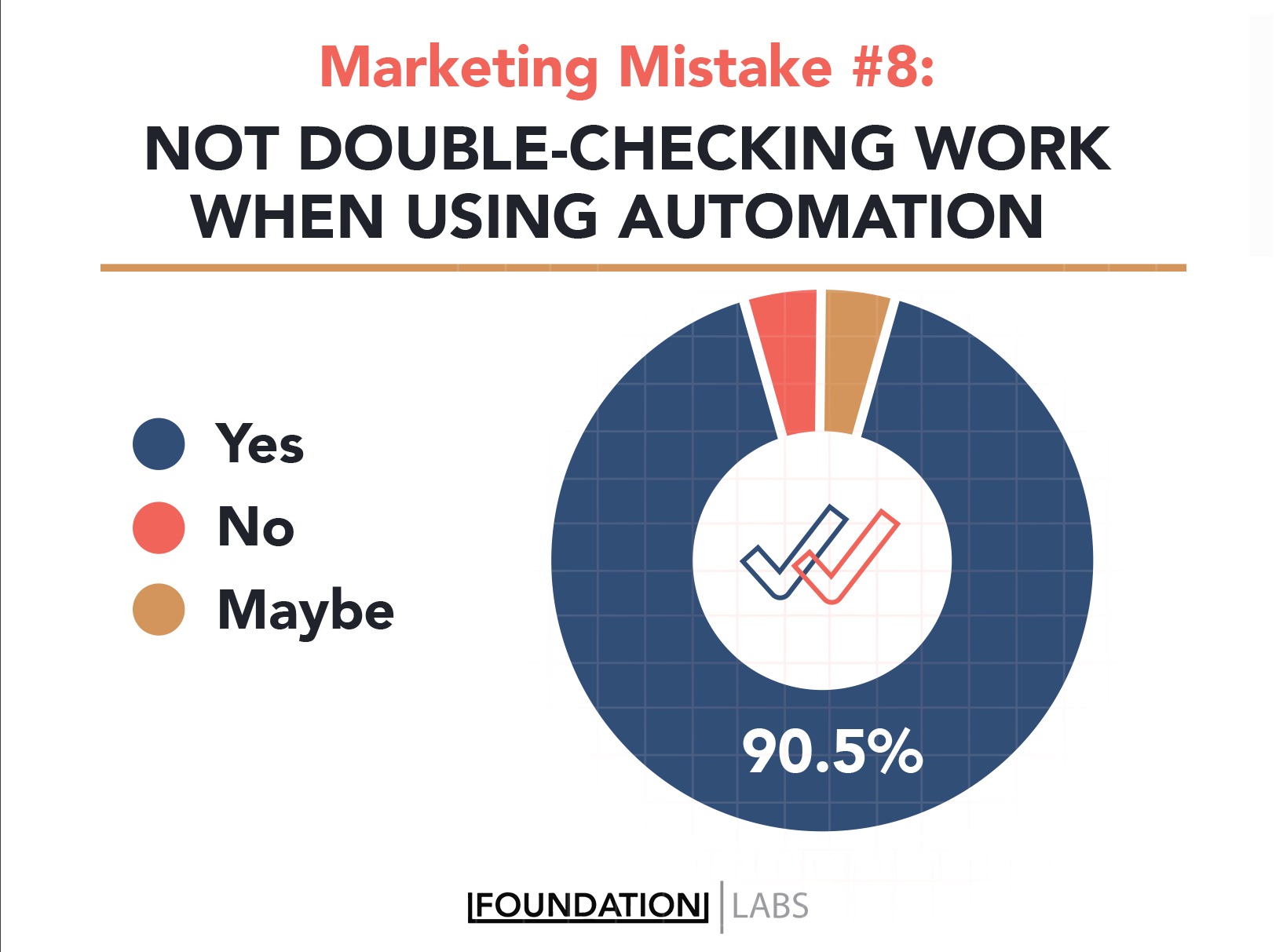
Marketing automation bloopers are more common than you’d imagine—90.5% of our respondents have been the victims of automation gone wrong.
These days it seems like no campaign is completely automation-free. But automation frequently backfires, and if we aren’t vigilant, we can end up with egg on our face.
Alaura Weaver, a content marketing strategist, shared her experience with automation failure:
I sent out a product launch announcement to a huge segment of my list with a merge field formatted wrong, so everyone got an email that started with “Hi, FIRSTNAME!
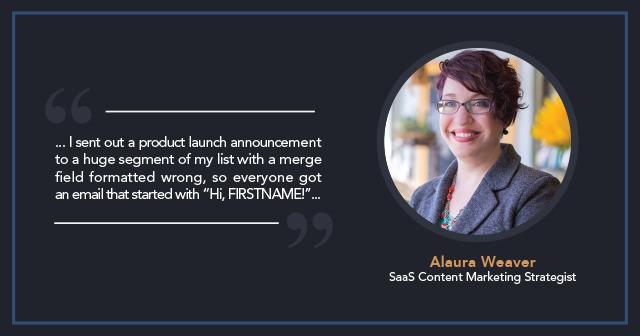
Sounds nightmarish, right?
Not if you own up to the error and turn it into an opportunity, as Alaura did:
I realized my faux pas immediately and wrote a quick follow up email to apologize for the mistake (after all, my entire brand is centered on making business personal). I also took it as an opportunity to discuss the importance of testing emails before they go out and how to handle email mistakes. PS: the apology email got way more opens than any of my newsletters!
Key Takeaway:
Mistakes happen, even with robots and computers. When using marketing automation tools, take extra time to check over your work. If a mistake still slips through, quickly own up—that shows your human side and actually increases relatability with your audience.
Marketing Mistake #9: Targeting Too Broad An Audience
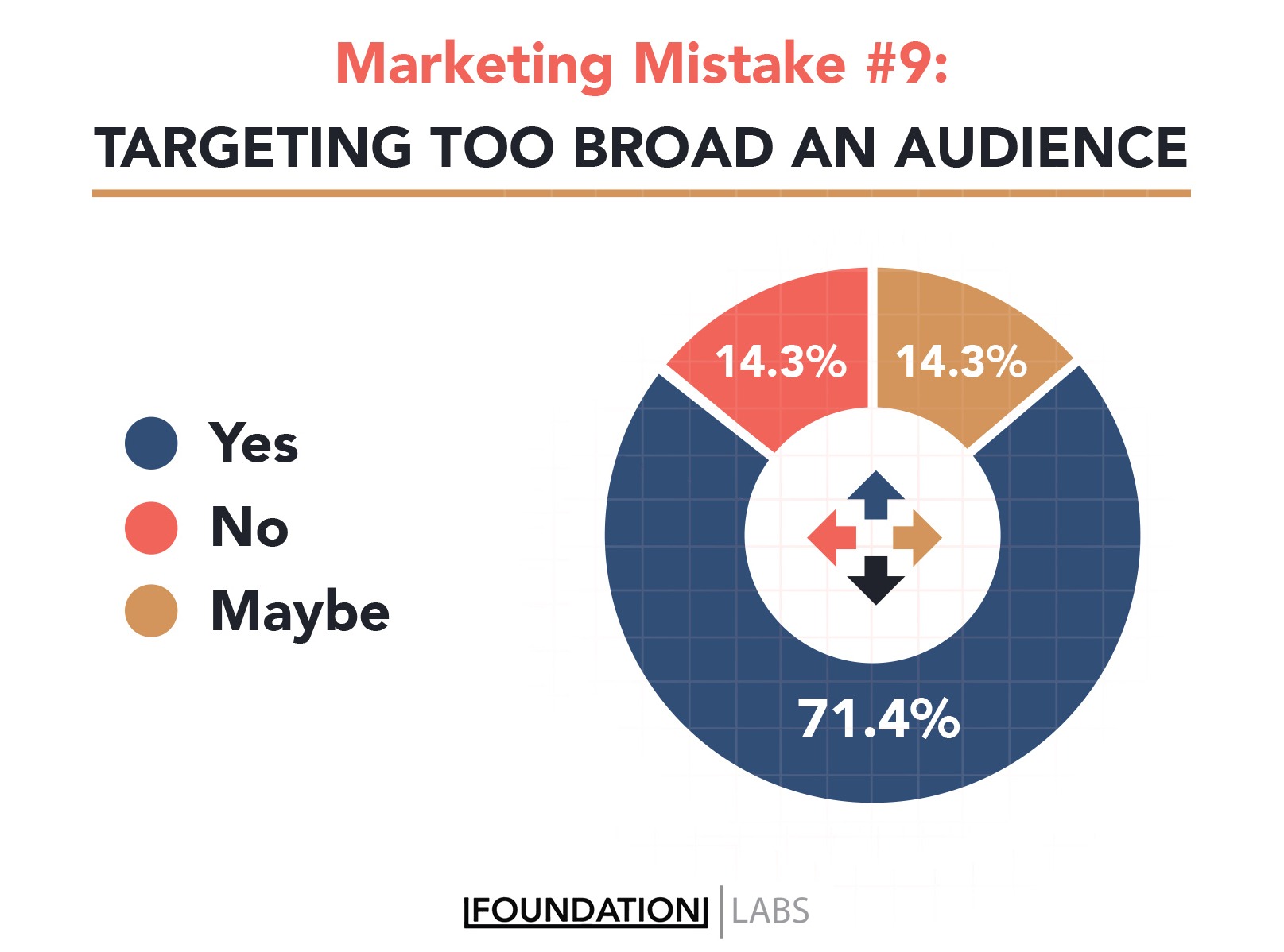
One of the basic prerequisites for marketers is knowing their target audience—you can’t go too narrow, but you can’t go too broad either.
Sometimes that’s a hard balance to find—in fact, 71.4% of our survey respondents said they have targeted too broad an audience.
Naser Alubaidi, a Growth marketer at Venngage, explains why “going after everyone” is a strategy that’s best avoided:
The idea of finding your ‘ideal audience’ and having a specific persona sounds really cliche at times, but it’s actually very true. What ends up happening in most cases where you try to promote to everyone is that you end up getting nobody.
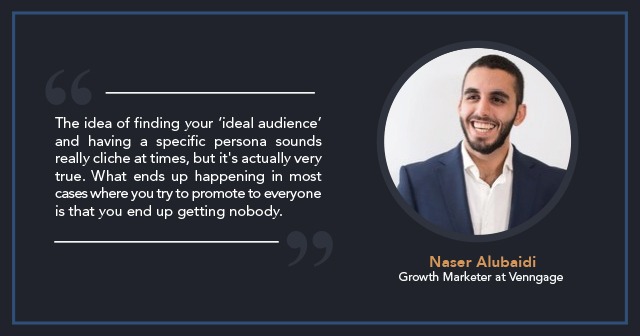
Josh Gallant, Digital marketer at Foundation, told us how going too broad with his audience impacted his paid ad campaigns:
We’ve all heard the quote by now—if you’re speaking to everyone, you’re speaking to no one. This is especially true when it comes to your targeting for Facebook ads. I was promoting a guide that helped marketers create better content and figured ALL marketers would be interested, so instead of creating a target persona I just pushed it to any and every marketer on Facebook. Once I took a step back and mapped out who would be most interested in the guide, the audience got a lot smaller and the results got a lot better.
Key Takeaway:
While a few campaigns may benefit from a “start broad” approach, in most cases aligning your strategy to your target audience is the best approach. It saves time and money and helps you convert more of the people you want.
Marketing Mistake #10: Not Doing Your Homework In A New Space
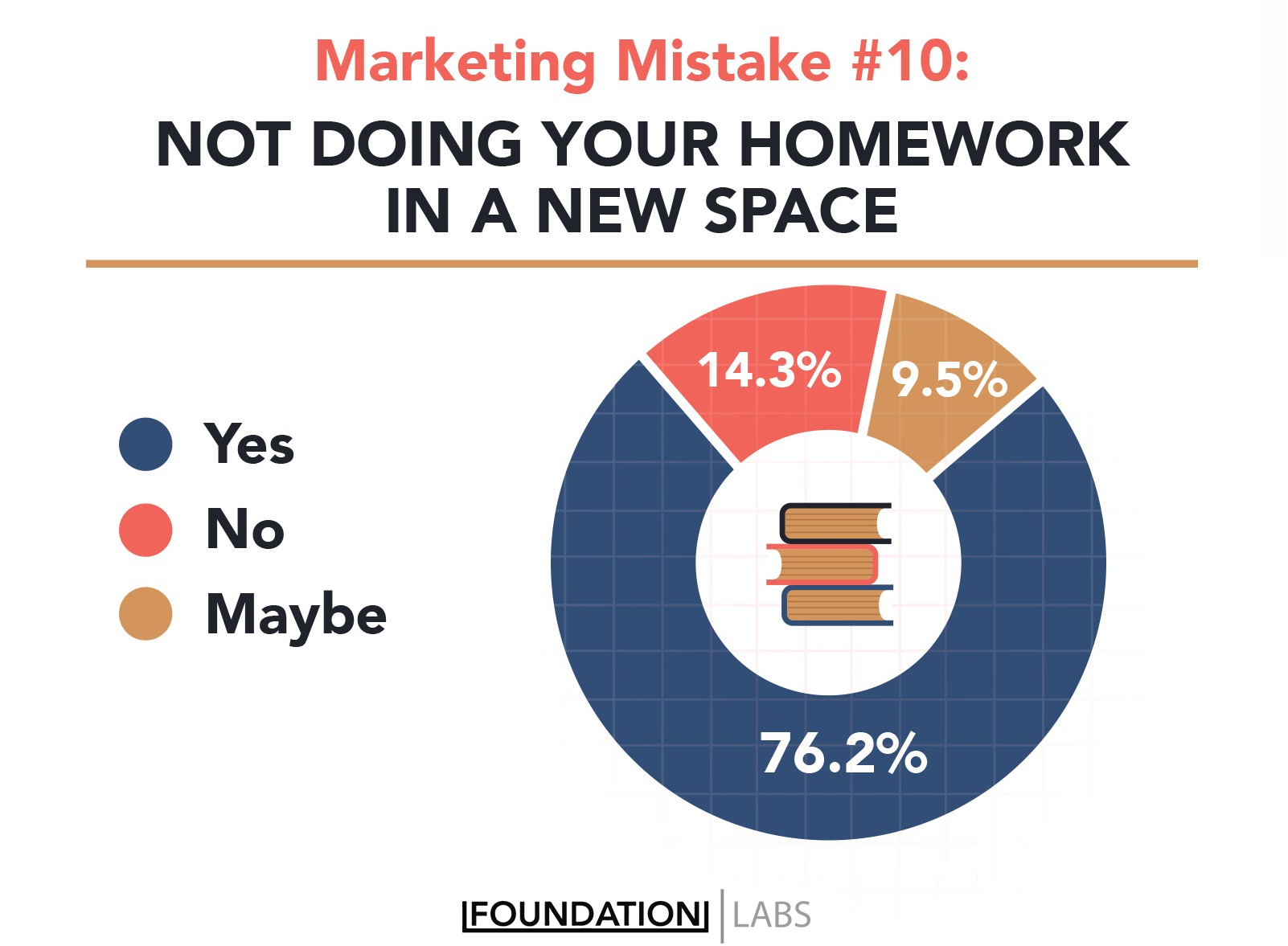
Most memorable campaigns are the result of homework done right—but that component is often missing when marketers want to test new concepts and platforms.
76.2% of marketers who took our survey admitted to entering a new space unprepared.
Gilles De Clerck, founder and growth strategist at ABLAZE Growth Studio, says familiarity is a two-way street—you need to lay the groundwork for people to know and trust you before asking for something in return:
I’d reach out to influencers in the space and asked them if they could ‘give us their two cents’ on our product or to hop on a call to get insights from. I thought I was being smart not asking to write something about us and that I valued their opinion. What I didn’t realize is that I was still asking for them to spend time on me while I myself was a total stranger to them.
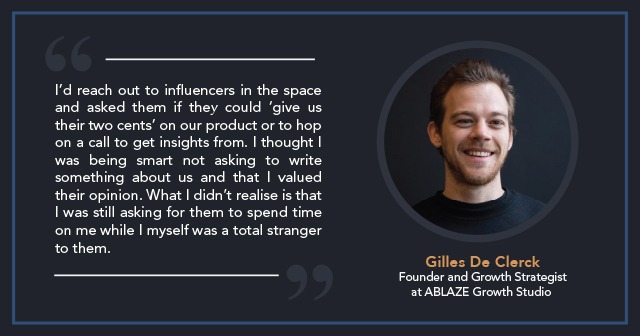
Ross Simmonds, Digital strategist at Foundation, had a similar experience when testing a new platform for content distribution:
The first time I attempted to use Reddit for marketing, I fell flat on my face. A few days later I got a notification that I was banned. I learned the importance of truly understanding the communities you’re trying to leverage before jumping in and trying to drive traffic. Our research shows that Redditors love links but what’s more important than anything is the relevance and value those links add to the community.

While Gilles’ and Ross’ experiences had more to do with testing new platforms and engaging with people in a new space, Matthew Spurr, co-founder at Quuu, and Alina Benny, growth marketer at Nextiva, both experienced the consequences of working with a new medium or agency without doing their due diligence.
Here’s Matthew’s story:
We wanted to shoot a cool video to advertise Quuu’s service and how it worked. We’ve always had explainer videos, but we wanted one with real actors, something that showcased our lighthearted brand.
However, it soon became apparent that when we went to edit the rushes from our shoot, that the sound quality was way off. It was a total disaster, we didn’t have anything useful that we could use. The idea was great, but the execution and organiation was abysmal. We wasted time and money and as far as a marketing exercise was concerned it was a big fat fail—it still makes me cringe.

Alina’s story also involves an explainer video. She and her team were working on a thin budget and hired an economical agency to create the video for them.
Her mistake was not vetting the agency or clarifying how they handled feedback and execution, which led to a horrible end product:
While we mentioned that we wanted to see references of the cast, costumes, rough cuts, etc. before they shot the whole video, we directly received version 1 from them.
We weren’t on the same page with most things on the video though we had a fully written out script and storyboard. Even after 3 minor revisions, we still had a sub-par video and in the time that we were working on this video, the company launched 2 new products.
The upshot—the video was obsolete, we’d burnt a lot of money and we had no salvageable end product.

Key Takeaway:
Whether you want to experiment with a new platform or partner with a new agency, doing your homework matters. Don’t jump right in; instead, take baby steps—do your research, learn from others with experience in that space, make a concrete plan (and a backup plan in case things go wrong), and lay the groundwork for mutual trust.
Marketing Mistake #11: Not Knowing What Customers Want
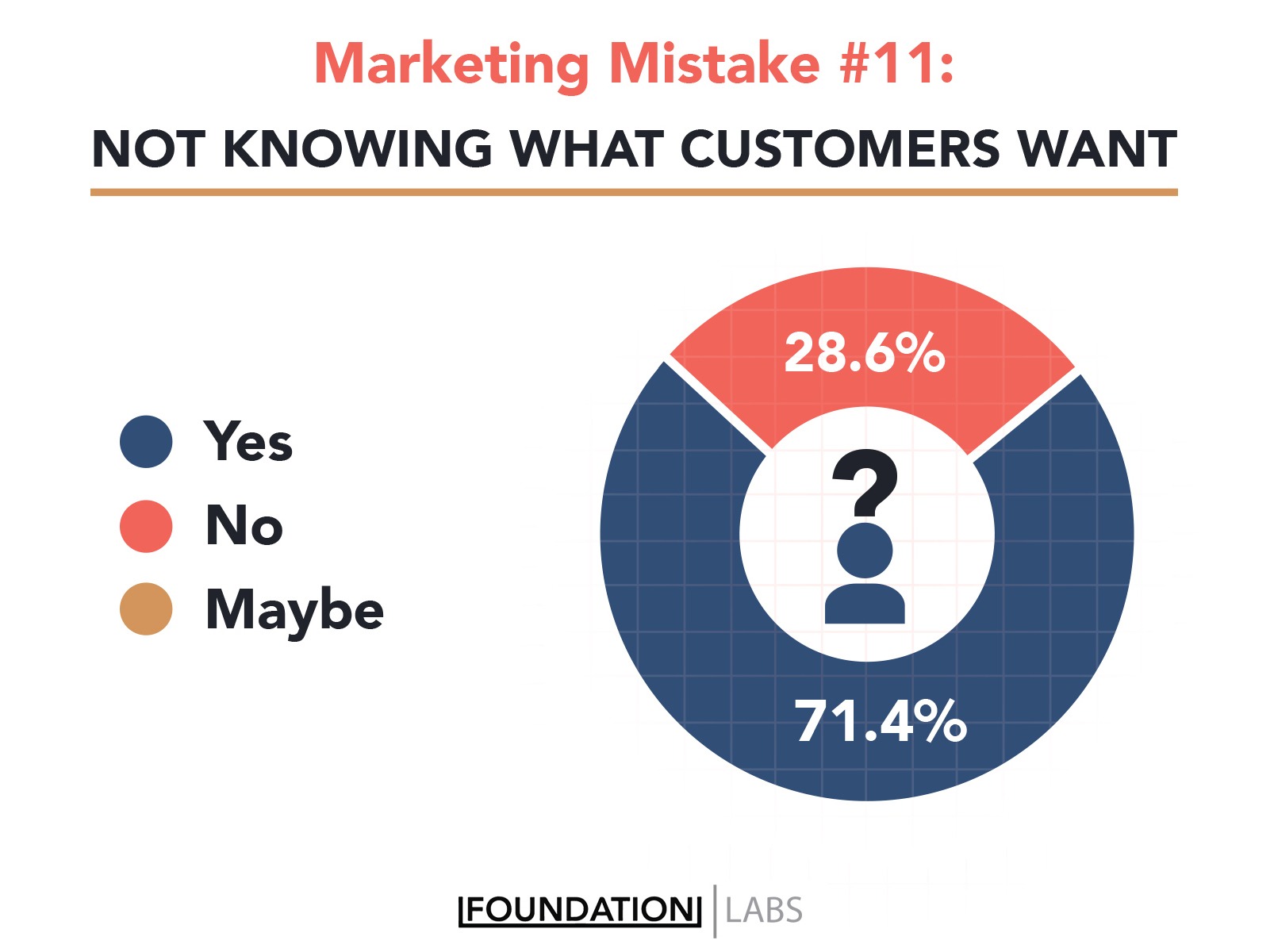
Customer research is unparalleled when it comes to identifying who your customers are (and who they are not), what they want and how your product can help them solve a problem. While customer research should be a central component of every marketing strategy, it’s often neglected by marketers because it takes time and resources.
71.4% of marketers told us they have made this mistake.
Without research, you are essentially shooting in the dark with your marketing campaigns. And even if you know a lot of facts about your target audience, you have to understand their wants and needs and where exactly your product fits into those in order to craft effective marketing messages.
Paul Campillo, a strong advocate of customer research, shares how Typeform benefited from in-depth customer interviews:
Typeform wanted a stronger go-to-market strategy but didn’t know which market to tackle (since forms are a very horizontal product). So I was a part of a research team to conduct jobs-to-be-done interviews, which we did, and the results were eye-opening. Bottom line: it changed how we build product, how we’ll market Typeform in the future, and where we can innovate.
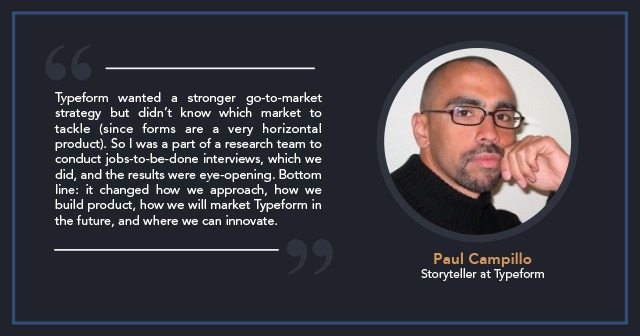
But here’s a thing about customer research: You need to invest enough time and resources to go deep in order to reap the full benefits.
Brandon Gains, VP of marketing at MonetizeMore, explains the approach that marketers are usually tempted to take:
We start creating buyer personas with the best of intentions, mapping out pain points and key concerns from customer interviews. Unfortunately, we don’t continue down that path of buyer decision modeling and start filling out their profiles with demographic stats that don’t help the process. We have a tendency to create personas based off of our gut feeling instead of doing the work to set up actual customer interviews and internal discussions across sales, customer success, product, and marketing departments.
This surface-level approach just plain doesn’t work, Brandon says. Instead, it “damages the strategic value of a buyer persona project in the first place and you won’t get the departmental buy-in across your organization that you’re looking for.”
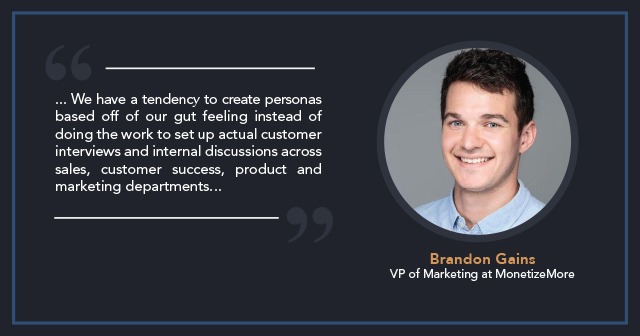
Instead of doing their own customer research, some marketers just try to imitate their competitors—that’s also a mistake. When marketers do this, they are essentially banking on other people’s research and trusting that their strategies will be effective. But most of the time, this approach neither leads to conversions nor delivers any value to the customer.
Robert Katai from Creatopy learned this the hard way:
I started blogging without understanding the real concept behind content and marketing. I thought that if only I publish content on a B2B blog and copy what others do, I will succeed. But the traffic was the same, didn’t get any social share and I had some hard time to understand why it’s not working.
Nivas Ravichandran from Freshsales has a similar story:
Early on in my marketing career, I was not interacting or listening to the community of our vertical as much as I should have been. I feel the marketing decisions or content in my early career days could have been more informed if I was interacting with the community regularly.
Key Takeaway:
Marketing campaigns are only effective if marketers know what their customers want—and that requires customer research. Don’t blindly follow what you see other marketers doing; talk to your own customers to find out what problems they have and how best to reach them.
Marketing Mistake #12: Trying To Do Everything On Your Own
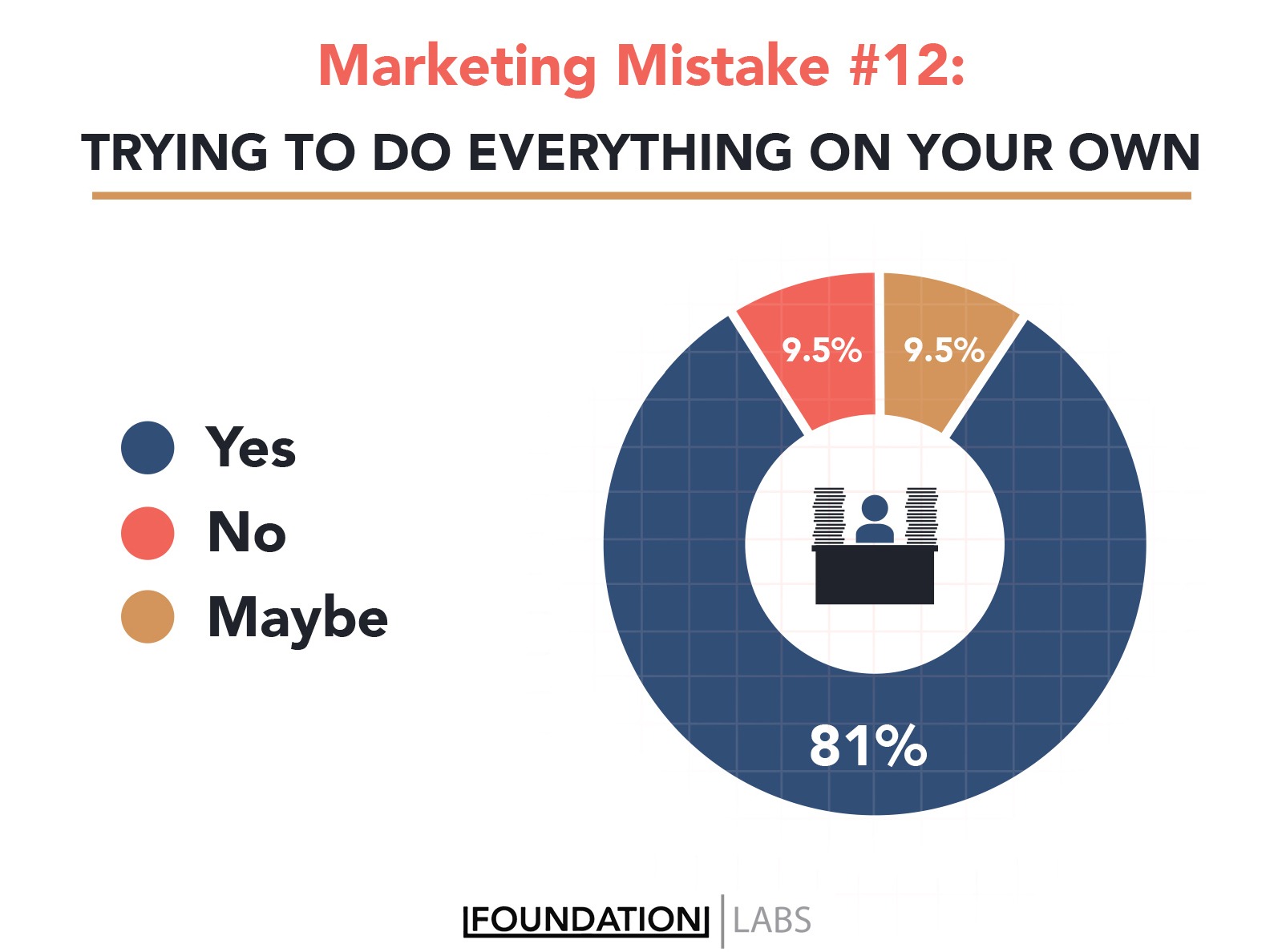
A marketing team’s success is crucial to business growth. This team takes on challenges, experiments with new ideas, and eagerly explores unknown territories.
However, in smaller companies and startups, marketers have a lot on their plates. They are responsible for leading projects with limited budgets and resources. In those situations, a marketer may be tempted to do everything on their own.
81% of the marketers in our survey have been there, done that—or at least, they’ve tried to. That’s the problem: Trying to do everything by yourself usually doesn’t work.
Cara Hogan, Content strategist at Zaius, spent hours teaching herself audio editing in order to launch her first podcast:
I was convinced that I had to do everything myself without any help from others. I definitely wasted hours and hours of time teaching myself. This took away from the time I needed to promote the show and grow the audience.
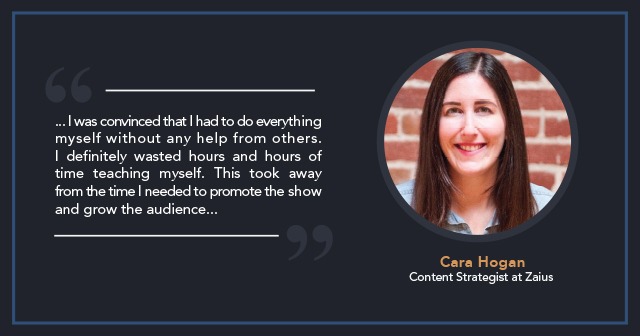
It’s important to realize when you need to ask others for help—or ask leadership to give you more resources to work with.
But on the flip side, you also need to recognize the line between getting help and taking advantage of someone else’s time, a line that Nichole Elizabeth DeMeré, B2C and B2B SaaS consultant, once crossed accidentally:
I mistook someone as a mentor (we never had an official conversation about it), when they were just trying to be a helpful friend when they had the time. I was just getting into Customer Success and I would ask them questions all the time but I didn’t realize I was asking too much of them.
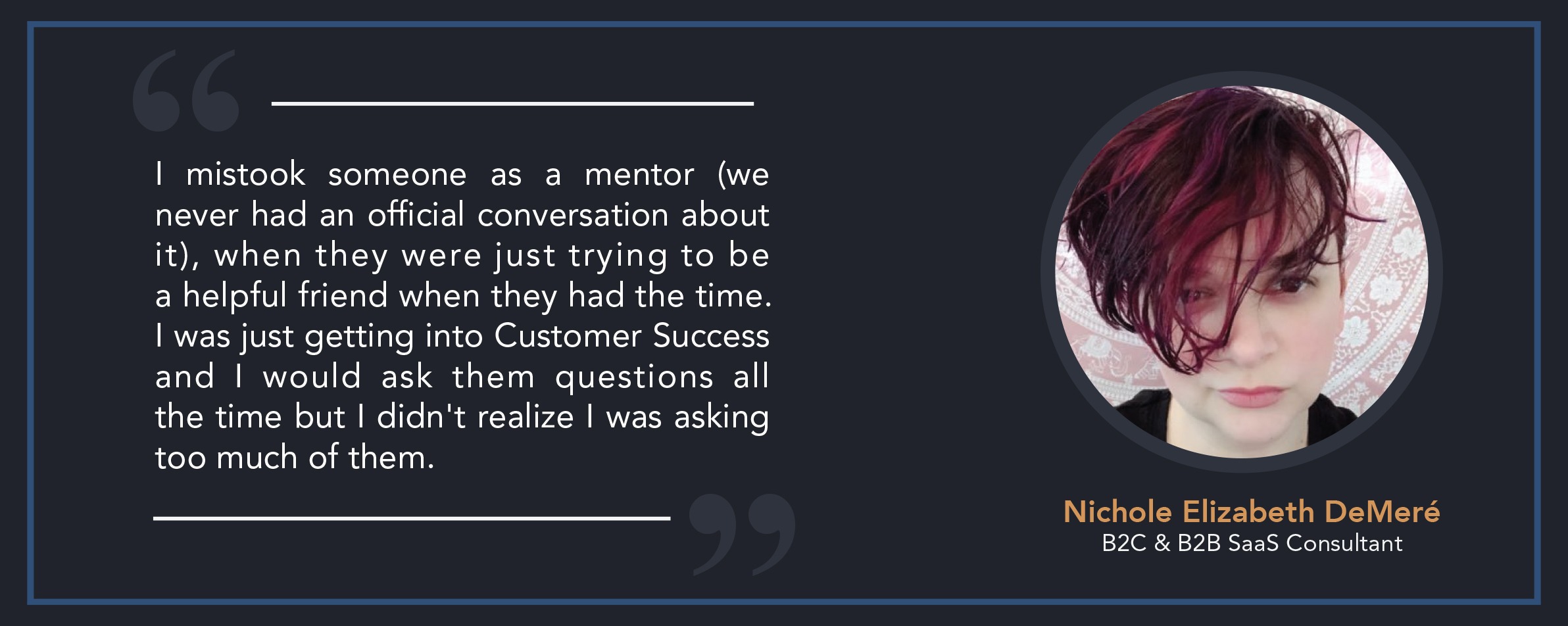
Key Takeaway:
When you have multiple tasks to juggle, there’s only so much you can do. Be realistic about what you can and can’t do, and learn to seek help from appropriate sources.
Marketing Mistake #13: Cutting Corners
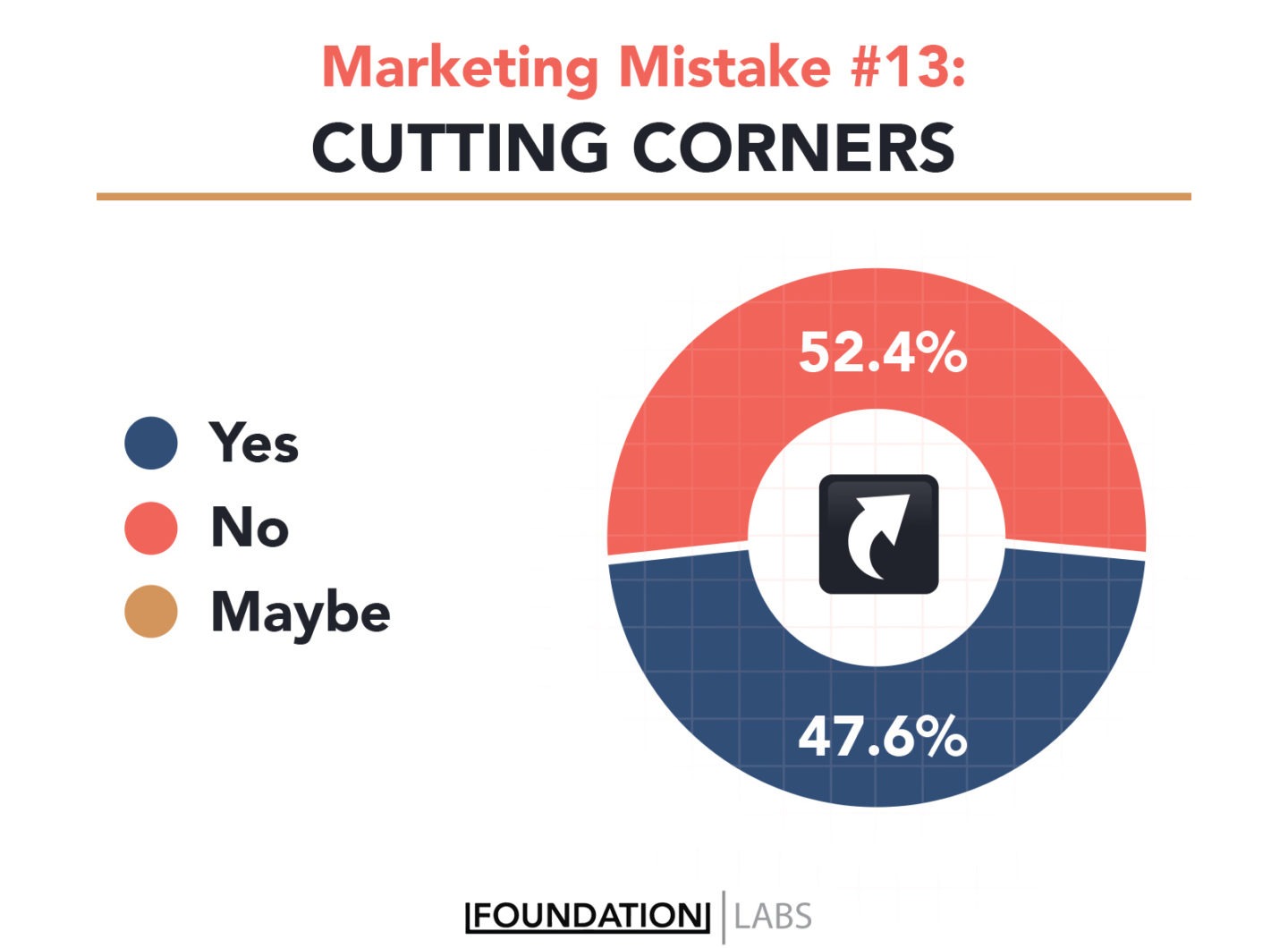
When designing a marketing campaign, the general goal is to grab and keep the customer’s attention. That’s not easy to do! For the sake of expediency, sometimes we end up using tactics that look promising on the surface but that ultimately can’t compare to a thoughtful, well-researched campaign. For example, have you ever bought a mailing list or paid for social media followers?
If you’ve cut corners in your career, you’re not alone—almost half the marketers we surveyed said they’ve done it too.
Madhav Bhandari, a remote marketing manager, once paid for upvotes—and it didn’t work:
In an effort to get more traffic to our blog, we hired an upvotes agency as part of our content promotion process. They claimed to get us enough genuine upvotes to get our post trending on the front page of Reddit, Hacker News and other communities. We did trend, we did get the traffic, but we didn’t get any customers, our brand got a lot of flak from the community and I felt horrible as a marketer.
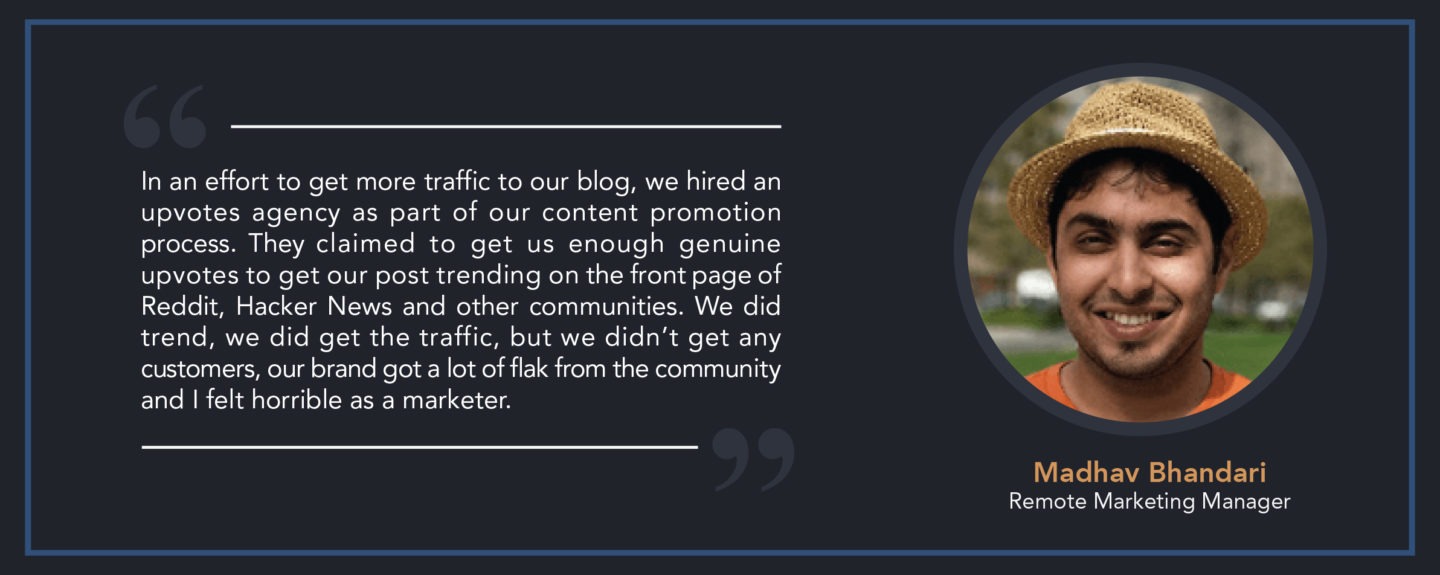
Not only was the strategy unsuccessful, but it also left a bad taste in their customers’ mouths.
Key Takeaway:
If you think your customers aren’t watching what you do, you’re wrong. That’s why it’s always prudent to be thoughtful, transparent and authentic when designing campaigns.
Conclusion
Marketing is tough—with so much riding on your performance, it’s easy to cut corners, act impulsively and ultimately make mistakes. Guess what? You’re in good company.
We hope these non-success stories from marketing experts will encourage you and help you improve your own campaigns. By knowing the most common marketing mistakes, you can avoid missteps and put processes in place to ensure success for your team and your company.
Still, mistakes will happen, and they may derail you for a bit. But if you reflect on what you learned, you can refocus on your goals and regain the trust of your customers.
So go out there and test new strategies, take risks and make mistakes—but don’t forget to learn from them.








